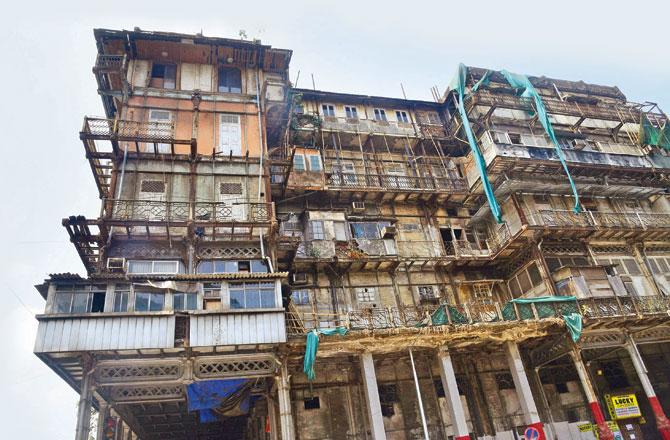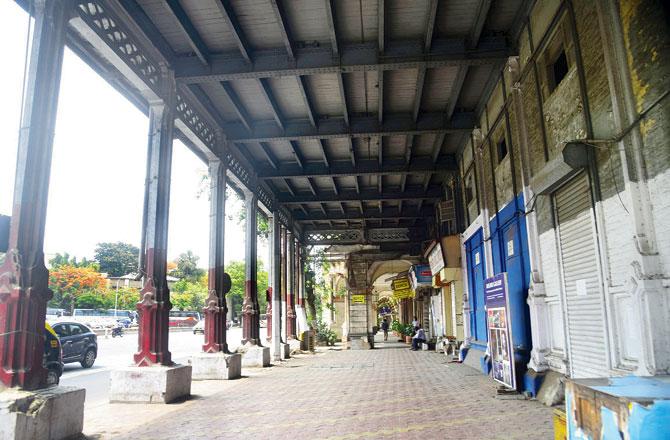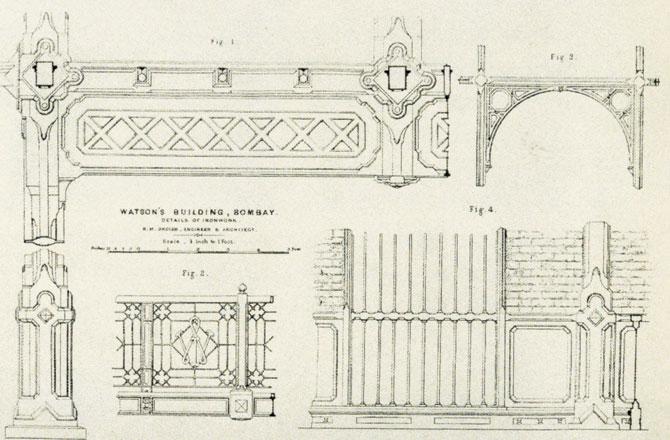Dr Christopher London, considered an expert on Kala Ghoda-s 147-year-old building of unique heritage value, now in controversy for IIT and MHADA-s pitch to tear it down, presents hard facts to argue why the cast-iron structure is built to survive

Esplanade is unique enough to be restored, say conservationists, because it is Indias only surviving cast-iron building. The frame was made entirely at Phoenix Foundry, London, and constructed on site in Fort from 1867-69. Its presence played a big part i
To the northwest of London, in a village hall in Castle Carrock, Cumbria, hangs an oil painting depicting a near-completed building in far off Bombay. This artist-s impression carries an interesting, detailed caption about The John Watson Building. It reads: -The iron frame from Derby, the bricks and cement from the Bank of Thames, the tiles from Staffordshire, red stone plinth and column bases from Penrith, Cumberland.-
ADVERTISEMENT
These materials referenced were shipped from England via the Cape of Good Hope in 1864-5, and used in the making of a luxury hotel in a neighbourhood that-s now known as Kala Ghoda. Castle Carrock was where Watson, a wealthy drapery and tailoring businessman who built the hotel, was born. When it opened to guests in February 1871, the building, designed by Rowland Mason Ordish, rewrote the rules of luxury hospitality in the British Empire.

Esplanade Mansion in its present condition
A little less than a century ago, it ceased to be a hotel. Errant tenants, an irresponsible landlord, and incessant changes to its interiors led to the slow ruin of what was once a hotel that hosted Mumbai-s grandest balls and welcomed guests of Mark Twain-s stature.
Last month, when IIT Bombay tabled a structural stability report of the building that-s now called Esplanade Mansion, they recommended that it be demolished, citing its irreparable condition. Accordingly, The Maharashtra Housing and Development Authority MHADA submitted a notice of motion to the High Court asking for its demolition. In a meeting held on June 12, members of the Mumbai Heritage Conservation Committee unanimously voted for the building-s preservation, and debated on how funds could be raised, including through crowd sourcing. They plan to submit a written response to MHADA this week.

In an exclusive interview to mid-day, Eric Falt, director, UNESCO cluster office, expressed doubt over whether the neighbourhood where the building stands would continue to hold the UNESCO World Heritage Site tag it earned in 2018 for the cluster of Art Deco buildings, and Victorian Gothic structures, including Esplanade, if the structure was demolished.
One of the first people to focus attention on this structure-s rich architectural worth was Dr Christopher W London, American author, academician and achitecturial historian. In 1986-87, London researched this building as part of his doctoral dissertation submission titled British Architecture in Victorian Bombay. This was for DPhil degree from Oxford University. He later included the research in his now famous book, Bombay Gothic, that chronicled a larger study of the city. In an interview to mid-day, London pokes holes in MHADA-s claim that Esplanade cannot withstand the test of time, making a strong case for its restoration.

The shops on the ground floor as seen in a current image and that from the 1880s, benefited from the protective mass of the overhanging building that provided convenient covered arcades for customers to browse while keeping them sheltered from sun and rain. This was another first for Bombay, and replicated later across all buildings on DN Road. Aarhival Pics/Pictor pulishing
Edited excerpts from the interview.
Why should Esplanade not be demolished after it has been declared dangerous, and how do you propose it be saved?
Cast iron buildings like Watson-s Esplanade Mansion are by nature composed of replaceable parts. That is the whole idea of the technology this building introduced, and utilised. [Replacement] is in its design DNA, as it were. So, it is obviously restorable, if an interested party wishes to do it. The required parts can be fabricated basis research. The movement can be arrested and corrected by pulling back the shifting elements and reaffixing them to the proper pins and supports of the original design. Cast iron is a very rigid material. It is not pre-disposed to bending. It is also very difficult to cut. It can corrode, which can weaken or destroy elements, if not kept in repair or unattended for many years, but, cast iron handles loads very well, and Watson-s is probably overbuilt, since it is an early example of this type of work. Watson-s much abused but standing state is a testament to both its strength and durability.

What do you mean by -overbuilt-?
Durability and strength were highly valued in 19th century constructions. So, this boldly innovative work would have been detailed to the last [detail]. With an eye on longevity, it would have been designed in a manner that incorporated a tolerance above and beyond expected load conditions.
What about the present condition of the precarious walls and its ability to withstand earthquakes?
The walls are merely partitions. They are not load bearing. So, the cracks in them are not a worry for the structural integrity of the building. The building is one of the first successful explorations of -curtain wall- construction anywhere in the world. It is a totally pre-fabricated cast-iron skeletal structure, with brick non-load bearing insertions, which were a novelty for Bombay architecture. If repaired, and its history and significance explained to people, it would be cause of celebration if restored. That-s better than a disregarded memory of what had been there, if demolished. As for its ability to withstand earthquakes, well you would need to tear down much of present day Mumbai, to deal with that [fear]. It is not reason to demolish a historic structure of significance. It is a red herring of an argument. Watson-s has withstood tremors to date, and though not designed specifically to resist earthquakes, it was a significant improvement on the plain masonry buildings of its era.

A damaged balcony reflects the ironwork details of grilles and brick infill as seen in archival drawings
In your estimate, how long would it take to restore a building like it?
It-s a difficult question to answer without a detailed study of the building-s present conditions. But, if clear access were provided for works, I would think perhaps two years might be sufficient to identify, make castings, rectify structural issues and install all necessary repairs. If there is grave rust and if all the vertical supporting elements need replacing, possibly a longer time needs to be considered.
What about expertise?
A well-trained structural engineering firm, working with a conservation architectural practice should be able to undertake this, locally. If not, I am sure a British or foreign firm would be approachable, considering the project-s unique architectural and historic connect with Great Britain.

Dr Christopher London
June 12
Day Mumbai Heritage Committee members unanimously voted against the former hotel-s demolition
Mondays for dancing
Five months after its opening an advertisement stated some of the unique items on the menu like French percolators for making coffee, bottled fruits like gooseberries and rhubarbs, and even "Figured Moguls" playing cards for sale. The ball at Watson-s, according to records was held on Mondays, where "an excellent band was engaged for the occasion, and dancing was kept up until an early hour."
Kipling wrote about it, too
The Watson-s Hotel earned such favour that it was fictionalized in two of Rudyard Kipling-s writings
A -quasi-single- bachelor pad
The Watson-s Hotel boasted a sumptuous, top lit ground floor restaurant with an attached billiard room. Three upper storeys given over to 131 bedrooms and apartments while the uppermost were reserved for "bachelors and quasi single gentlemen". With over 120 fitted baths, it boasted of a punkah wallah in every room with stunning views across the harbour, bays and distant hills of the mainland. It was also home to India-s first steam powered lift.
Catch up on all the latest Mumbai news, crime news, current affairs, and also a complete guide on Mumbai from food to things to do and events across the city here. Also download the new mid-day Android and iOS apps to get latest updates
 Subscribe today by clicking the link and stay updated with the latest news!" Click here!
Subscribe today by clicking the link and stay updated with the latest news!" Click here!






